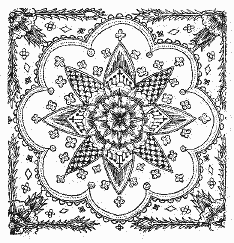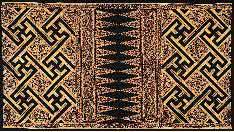Mathematics and Art
3. Symmetry
Art critics have evolved a language for discussing and analyzing art. It turns out that some mathematics can also be useful in analyzing art. Some art or pieces of art consist of things that are pleasing to the eye because they are symmetrical in a mathematical sense. Although the study of symmetry has implicitly been done within mathematics for a long time, in some ways its systematic study is quite recent. It was Felix Klein (1849-1925) who called attention to the fact that one way of classifying different kinds of geometries is to look at the geometric transformations in each of these geometries that preserve interesting properties. In particular, it is of interest in Euclidean, spherical, or Bolyai-Lobachevsky geometry to look at the geometric transformations that are isometries. An isometry is a transformation that preserves distance.
Of course, it is important to keep in mind that many of the pieces of art that mathematicians (and others) analyze using mathematical ideas may not reflect attempts on the part of the artist to incorporate these mathematical ideas in his/her work. Just as someone who makes a cubical box may not realize that the cube is a regular polyhedron (one where all the vertices are alike and where all the faces are congruent regular polygons), a maker of a weaving may not know anything about isometries. The isometries in the Euclidean plane are translations, rotations, reflections and glide reflections. Thus, a mathematician may state which isometries are used in the design of a rug, but that does not mean that the designer of the rug invoked any mathematical thinking. Social scientists have used symmetry ideas and the conservatism of the mechanisms of cultural transmission in their studies. Archeologists and anthropologists have attempted to use symmetry ideas to date artifacts (pottery or fabrics) and to study trade and patterns of commerce.
A major tool in the analysis of symmetry has been the concept of a group.The group concept has a rich and complicated history with ties to the study of the theory of equations (attempts to show that one could not find formulas to solve quintic polynomial equations). By late in the 19th century, group theory was being used as a tool to help crystallographers understand the symmetry of crystals and other naturally occurring structures. Out of this interest grew the work that made possible the classification of tilings and patterns using group theory considerations.
One can also look at the symmetry of a single motif or ornament. Examples of such motifs (illustrated from patterns used in batiks) are shown below. Such ornaments typically have rotational symmetry and/or reflection symmetry.


A more complex pattern such as the one below can be built up from simple motifs. Such patterns have translational symmetry in one direction. Designs or patterns of this kind are known as strip, band, or frieze patterns.

The motifs used to make such frieze patterns may be isolated from one another or coalesce into a "continuous" geometric design along the strip. If a pattern has translations in two directions, then the pattern is often referred to as a wallpaper pattern.
Whereas an artist may choose to create a pattern with absolute and strict adherence in all details to have symmetry in the pattern, this is not all that common for "tribal" artists or artisans. Thus, if one looks carefully at a rug which at first view looks very symmetrical, it is common to see that at a more detailed level it is not quite totally symmetric either in the use of the design or of the colors used in different parts of the design. One can see the small liberties that are taken either because of the difficulty of making patterns exact by hand or because the artist wants consciously to make such small variations. In analyzing the symmetry of such a pattern it probably makes sense to idealize what the artist has done before applying some mathematical classification of the symmetry involved.
In the patterns shown above no color appears. We have a black design on a white background. However, in discussing the symmetry of a pattern one can study the symmetry involved if color is disregarded or by taking color into account. If you look at the batik below from a symmetry point of view you must idealize (model) what is going on to use mathematics. This batik is not infinite in either one or two directions. You must decide what colors have been used and what is the background color.

Many find it interesting to use mathematics to decide what symmetry pattern is involved for various interpretations of the whole or parts of a design. E. Fedorov (1859-1919) enumerated the seventeen 2-dimensional patterns in 1891 in a paper which did not receive wide attention because it was in Russian. P. Niggli (1888-1953) and G. Polya (1887-1985) developed the seven 1-dimensional and the seventeen 2-dimensional patterns in the 1920's; it was through this work that a mathematical approach to the analysis of symmetry patterns became more widely known. One extension of this work to color symmetry was accomplished by H. Woods in the 1930's. It turns out that there are 46 two-color types of patterns. Subsequently much work has been done with regard to studying symmetry in higher-dimensional spaces and using many colors. Recently Branko Grünbaum and Geoffrey Shephard, in a long series of joint papers and in their seminal book Tilings and Patterns, explored many extensions and facets of pattern, tilings, and their symmetries. In particular, Grünbaum and Shephard explored the interaction between symmetry and the use of a motif. This enabled them, for example, to develop a "finer" classification of the seven frieze patterns and seventeen wallpaper patterns. Unfortunately, this work is not as widely known as it should be.
Many people have been instrumental in disseminating mathematical knowledge of symmetry and pattern to scholars outside of mathematics as well as to the general public. One of the most influential and early books of this kind was Hermann Weyl (1885-1955)'s book Symmetry. Also noteworthy among these popularizers are Doris Schattschneider, Branko Grünbaum, Geoffrey Shephard, Marjorie Senechal, Michele Emmer, H. S. M. Coxeter, Dorothy Washburn (an anthropologist), Donald Crowe and Kim Williams. These individuals called attention to the use of symmetry as a tool for insight into various aspects of fabrics, ethnic designs and culture, architecture, and art, as well as to artists such as Escher whose work tantalizes people with a mathematical bent.
-
Introduction
-
Mathematical tools for artists
-
Symmetry
-
Mathematical artists and artist mathematicians
-
Polyhedra, tilings, and dissections
-
Origami
-
References






